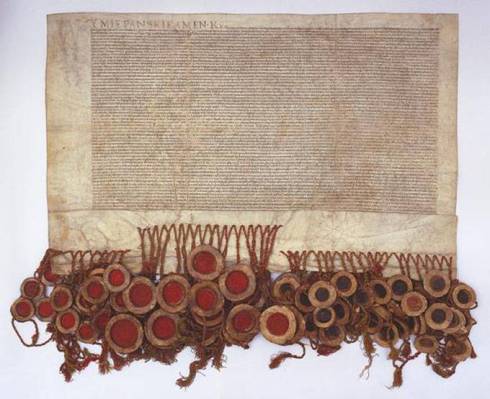Yesterday I went with a Canadian friend to see the Millennium exhibits at the Applied Art Museum. The museum currently has several exhibits in honor of the 1,000 year anniversary of the mention of Lithuania in written sources. One of the exhibits, The Art of the Balts, displays jewelry, metal work, amber and ceramics from as early as 1,000 years ago to today. The artifacts came from archeological digs in the regions where the Baltic peoples (Lithuanians, Latvians and Prussians) historically lived. In particular, the exhibit takes one item — pins and clasps that would have been worn on clothing — and traces the development of this item over the centuries. It is an interesting exhibit with many beautiful pieces on display.
But I really got excited about the other exhibit — Lithuania in Ancient Historical Sources. I like old stuff but I love old documents. I think this is why I am a historian and not an archeologist. Original documents that mention Lithuania dating from 1255 to the 1990 declaration of independence from the Soviet Union are displayed in two large rooms. Most of the documents are pre-1900 and there were many documents from the 13th-17th century. I am not a medievalist by any stretch, but I was thrilled to see ancient documents about important historical events that I have studied.
Most of the really old documents are related to peace treaties between Lithuania and its neighbors, particularly the Teutonic Order to the west and the Russian city-states to the east. Some are grants of land and privileges to various individuals, towns or groups, such as the Karaites, a Turkic people who settle in Lithuania in 1392. I was particular interested in the seals on the ancient documents. Some documents had quite a few seals attached, presumably from each of the signatories to the document. A few documents, especially those by Russian tsars, had huge seals — six inches in diameter and encased in metal. The seals were all attached to the documents with cords. I was surprised that the weight of the seals didn’t rip the paper, but I guess they figured out ways to deal with that since it was a common practice for centuries. The writing was still legible and it was fun to try to decipher a little bit of old German, Polish and Slavonic. I might even go back and see the exhibit again, I liked it so much!

The Lublin Act of 1569, which created the Commonwealth of Poland and Lithuania (Archives of the National Museum of Lithuania)

3 comments
Comments feed for this article
July 23, 2009 at 9:54 pm
Susan Andersen
I love this photograph, Amanda! There is something truly exciting about old text. I think it confirms — for those of us who spend our lives as scholars and writers — that our labors may be of value, if only generations hence. I’m enjoying your blog immensely — thanks for so many great insights and images!
April 3, 2012 at 7:20 am
Modris Strauss
Prussians, Baltic? Never! You wanted to write Estonians, in addition to Latvians and Lithuanians.
Prussians only sniff across the southern Baltic border.
Otherwise, I enjoy your descriptions.
April 3, 2012 at 4:49 pm
amanda
Linguistically speaking, the Baltic language group includes Lithuanian, Latvian, and Prussian. The Prussian language died out centuries ago under an influx of German-speakers into Prussia — that’s why we now think of “Prussians” as “German.” Estonians are part of the Finno-Ugric language group, which is related to Finnish and Hungarian. Of course, today’s definition of the “Baltics” is Lithuania, Latvia and Estonia — but that is a political construction rather than a linguistic category.